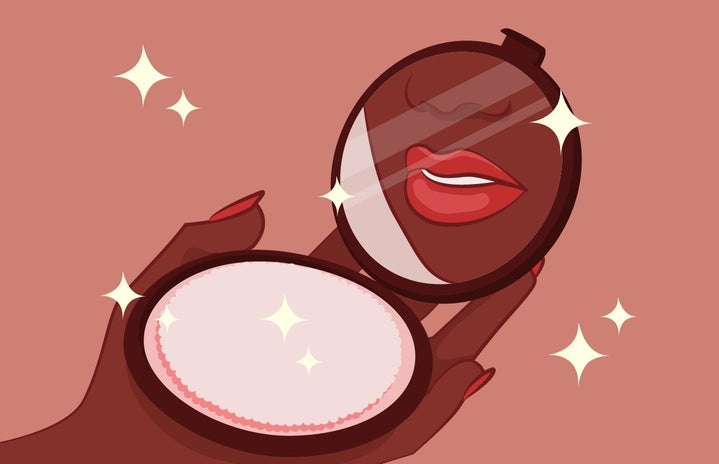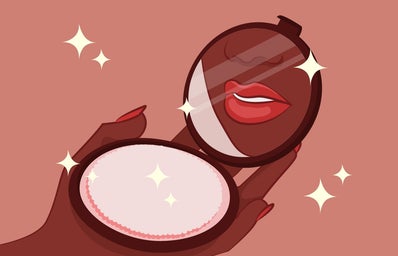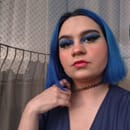The Elfgutz are mainly ball-jointed dolls, which are articulated toys, that were customised by their creator. These dolls have, as a main trait, dreamlike features, like elongated ears, or even extremely colorful hair and eyes. But, the biggest highlight in these puppets is the presence of non-healthy outlines, like wounds (some even exposed, others covered by bandages) and obviously, symptoms of respiratory diseases, like rhinitis itself!
By the beginning of the decade of 2010, an alternative field of fashion appeared: the Fairy Kei, which was style born in the district of Harajuku, located in the city of Tokyo, known by their aesthetic and fashion revolutions. Besides Harajuku, one of the triggers to the rhinitis symptoms start to be considered beautiful, was the trend of the “Human Dolls”, which also became popular by the beginning of 2010, specially when people started to feel inspired by the Elfgutz dolls to elaborate their makeup looks.
In nowadays, both the Fairy Key and the Elfgutz aesthetic gave birth to fashion trends just as the e-girls and the soft-girls, that often evidence the presence of traits like the reddened nose, dark circles, watery eyes. The e-girls and e-boys ended up gaining the highlights in contemporaneity, mixing up styles and becoming popular per social media and social networks, such as Instagram and mainly TikTok: revealing itself to be an urban and cosmopolitan way of fashion.
But why specifically rhinitis?
Mayara Dias, PhD in Pharmacology and Biotechnology from the Karolinska Institute, one of the biggest medical schools of Europe, explains that “although there are more and more evidence that suggests a correlation between rhinitis and urban environments, the researches are still conflicting. In some countries like China, this correlation is significative”. According to Dias, the rhinitis’ allergic crises are mostly triggered by Strong smells, such as perfumes, ink and cigarette smoke, which are commonly smelt in big cities, besides fuels and gasoline smoke. More important, this is no big news for the aesthetic ways of fashion, reminding that throughout the humanity’s history it’s possible to observe a peculiar process, in which illnesses’ symptoms became an aesthetic inspiration.
The XIX century was marked by a tuberculosis outbreak that devastated Europe and the United States. The infectious disease was like a stepwise march, slow and painful, leading to the sick person’s death. The antibiotics had not been developed and phthisis transformed the appearance of contaminated ones into distorted corpses. Truly, an horror novel scenario, but at the same time, something in that illness caught the victorian people’s attention: there was a creepy beauty in that pale skin, in those watering eyes, in the chattered lips that coughed blood. While the poor medicine at the time tried to explain the causes of tuberculosis, the disease started to dictate the fashion of that fateful historic time — specially into literature and into the plastic arts.
“Between 1780 and 1850 there was a increasing aestheticization of tuberculosis, which became intertwined with female beauty”, explains Carolyn Day, history’s associate professor at University Furman at South Carolina. She is the author of the book Consumptive Chic: A History of Fashion, Beauty and Disease, in which explores the impact caused by tuberculosis in the fashion sense and also in the perception of beauty amongst the british people during the XIX century.
In the aristocratic high society, according to Day, women were judged as having a bigger susceptibility to contract tuberculosis, just by the fact that the illness tended to highlight features such as extremely slimness and pale skin, shiny and enlarged eyes, red lips and rosy cheeks, in short, features that already were settled down as beauty standards for women at the time.
According to Igor Cabral Cesar, undergraduate student from the fashion course at Fundação Armando Alvares Penteado (FAAP), “fashion basically used to arise at first by influencing kings, consenquently the remainder court, and at last the burgeoisie. In according to the emergence of new aesthetics in the fashion fields, the presence of a hierarchy of power was always necessary. The most influent dictates the fashion.” Such structure may be observed mainly by the fact that the beauty archetypes, that happened to be highlighted by the phthisis symptoms, were typical from the noblility, the articulator of power at the time.
In nowadays, the spotlight belongs to the aesthetical use of the rhinitis symptoms, such as reddened nose, dark circles, watery eyes though makeup. “Precisely, it is this big variety of digital influencers that makes fashion transforms itself. The daring always will be seen as something new, even the eccentricity has its effect in fashion, by shocking its viewers. Things that shocks get people’s interest. Everything that once was a trend in fashion, caused a shock”, synthesizes Cesar.
The victorian aesthetic, influenced by tuberculosis, and the contemporary aesthetic, which has its inspirations in rhinitis symptoms, both became focused to a mostly female public. Even if in nowadays the aesthetic of e-girls and e-boys may be used by a unissex public, men in this alternative “urban tribe” tend to adopt an androgynous style, almost flirting with gender non-binarity. “Fashion always avolved through a concept. The thing with androgyny was to help LGBT+ social’s movements to arise and express itselves, all of that just through the way of getting dressed. Fashion has this exchange of influences with the environment”, points out Cesar.
According to the philosopher and psychoanalyst graduated from USP, Fábio M. Bittencourt Vargas, this social phenomenon abouth the glamourization of pathologies, mainly in the present, may be explained through the concept of the Secondary Gain. “Brought to light, at least related to psychoanalysis, in a text from 1926, ‘ inhibitions symptoms and anxiety’, Freud invites us to think about a very particular situation: to see how the sickness process brings sort of some advantadge. Either for the attention gaigned, by recognition, or by becoming a patient surrounded by care, the illness is unconsiously keeped.”
In addition to this first factor, according to Vargas, there’s even another way to understand this behavior: It ends up being justified by social distinction and by the recognition of similar ones through this aesthetic, after all, it comes to an alternative kind of fashion, that belongs to a restricted community. “Looks like we’re facing a curious fact, in which the complete absence of habilities, or titles, orpossessions is overwhelmed by the display of a disease! The evident signs of some pathological process converted into a process of social distinction.”
The psychoanalyst also theorizes that such search for being unlike leads these urban teenagers to appropriate the signs of this disease, and highlight them to shoot photos, emphasizing such traits and features through makeup in an aesthetical exposure. “In the world of stimuli, in the wild competition associated to our social reproduction models, wouldn’t be astonishing to find out that the human psyche is finding ways of social distinction and gains of recognition exactly by falling ill. It wouldn’t be the first time in history, and certainly, not the last one”, finalizes.
—————————————————————-
The article above was edited by Laura Ferrazzano.
Liked this type of content? Check Her Campus Casper Libero home page for more!



